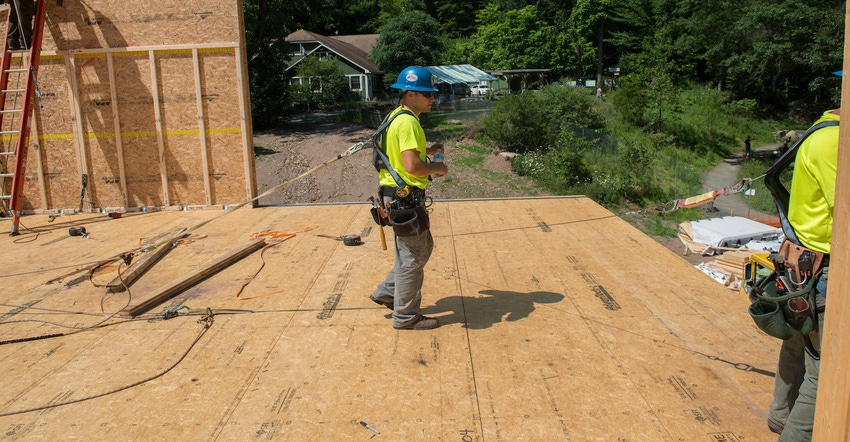How to Prevent Construction Injuries and Deaths From Falls
A survey conducted by the Center for Construction Research and Training indicated a greater need for fall prevention planning and self-rescue training.

As part of this year’s National Safety Stand-Down to Prevent Falls in Construction webinar series, speakers addressed a variety of safety topics related to the prevention of fall injuries and fatalities in all sectors of the industry. With 2021 data from the U.S. Bureau of Labor Statistics reporting 951 fatal work injuries in construction and extraction occupations—and 370 of those from falls, slips or trips—it is a topic that touches nearly everyone in construction.
“One of the biggest things we can do to mitigate these numbers is to plan for preventing falls,” said Rich Trewyn, the National Roofing Contractor Association’s director of enterprise risk management. “It starts early in the process—either pre-bid or pre-job—and should include everyone who steps onto the jobsite.”
Joining Trewyn for the webinar was Rosa Greenberg, a research analyst in the Research to Practice program at the Center for Construction Research and Training, also known as CPWR. Greenberg presented key findings from a CPWR survey on the underlying causes of falls from heights.
The voluntary and anonymous survey was available online in both English and Spanish for three months in early 2021. Respondents were asked to describe “a single specific fall incident they experienced, witnessed or investigated,” according to Greenberg. Those who wanted to describe more than one incident could take the survey multiple times.
A majority of the 671 participants worked in construction (63.8%), with an average of 25 years of industry experience. Of the respondents, more than 70% said the fall they witnessed was not fatal, but 64% indicated that emergency services were required—and almost 80% of those who fell required medical care.
Most falls occurred at heights of 6 feet or higher, with a third of the falls occurring at heights over 20 feet. Some of the top causes of the falls reported in the survey included insufficient or ineffective planning, lack of relevant training and improper use of fall protection or access equipment.
There were five key takeaways from this data, according to Greenberg:
1. More comprehensive planning for fall prevention is needed.
Survey participants believed that lack of adequate planning was the key cause of falls. When it comes to planning for fall protection and self rescue, Greenberg said, the survey results indicated that the odds of using fall protection were 71% lower for individuals whose employer did not do any planning, compared to those whose employer did plan.
“The most common type of planning was pre-job planning,” said Greenberg. “And following a fall incident, when employers did make changes, they implemented changes most often in training, policy, procedure and planning.”
2. In nearly half of all falls, no fall protection was being used.
When fall protection was used, personal fall arrest systems were the top choice described by respondents.
3. Employers should inform workers of and enforce company policies regarding fall protection.
Individuals who believed fall protection was required by their employer were eight times more likely to use fall protection compared to those who did not believe fall protection was required, according to the data presented by Greenberg.
4. Rescue training may help reduce fall-related deaths.
According to the survey, a majority of those who fell had at least one type of training at the time of the incident, with the most common training being for the use of the specific fall protection or arrest equipment being used at the time.
“In our analysis of fatal falls by type of training, we determined that the odds of a fall being fatal was 76% lower for those who had self-rescue training compared to those who did not have this training,” said Greenberg.
5. Workers employed by subcontractors face an elevated risk of dying from falls.
Individuals who worked for a subcontractor at the time of the fall were 2.7 times more likely to die from a fall compared to those who worked for a general contractor.
Greenberg noted that, with the survey completed, CPWR is now sharing the findings with the industry and creating resources and materials in support of planning for fall protection. The organization is also putting together an expert panel on fall protections that will use the survey findings to identify interventions on which CPRW with train its focus.
About the Author(s)
You May Also Like




